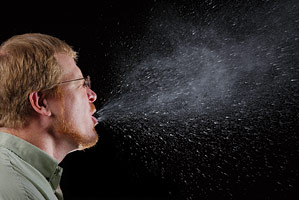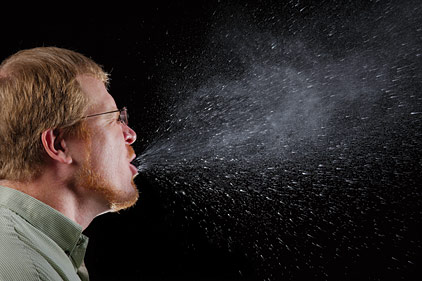 This season’s strain of Influenza A, also known as the flu, was particularly potent and widespread. The virus officially reached epidemic status in the U.S. the week of Jan. 5, when the percentage of total deaths caused by the flu surpassed the epidemic threshold of 7.2 percent. While the outbreak peaked in mid-January, the less severe Influenza B is expected to peak in March or April. For contractors, fighting the flu and other airborne illnesses offers a humanitarian service to society, as well as a potential boost to their bottom line.
This season’s strain of Influenza A, also known as the flu, was particularly potent and widespread. The virus officially reached epidemic status in the U.S. the week of Jan. 5, when the percentage of total deaths caused by the flu surpassed the epidemic threshold of 7.2 percent. While the outbreak peaked in mid-January, the less severe Influenza B is expected to peak in March or April. For contractors, fighting the flu and other airborne illnesses offers a humanitarian service to society, as well as a potential boost to their bottom line.
Influenza 101
The flu is a contagious respiratory illness caused by influenza viruses that can cause mild to severe illness and, in some cases, death. According to the Centers for Disease Control and Prevention (www.cdc.gov/flu), infants and young children, the elderly, and those with certain health conditions are at a higher risk for serious flu complications.
“The flu is spread through respiratory secretions, like coughing and sneezing,” explained Dr. Matthew Sims, director of infectious disease research for William Beaumont Hospital, Royal Oak, Mich. “In the air, it can survive basically until it’s dried out. Once it lands on surfaces, it has a maximum lifespan of about eight hours.”
At the 1,070-bed Beaumont Hospital, which is part of the sizable Michigan-based regional Beaumont Health System, Sims preaches hand washing, covering your cough, and staying home when ill as the best ways to keep from catching or spreading the virus. But, aside from taking the standard personal precautions, other things can be done to improve IAQ and limit the spread of the flu and other illnesses.
HEPA, HEPA, Hooray!
At Beaumont, High-Efficiency Particulate Air (HEPA) filters are frequently used to trap bacteria and viruses to keep them from spreading between rooms. Standards set forth by the U.S. Department of Energy (DOE) mandate that, in order to be classified as a true HEPA filter, the filter must trap a minimum of 99.97 percent of airborne particulates that are 0.3 micrometer in diameter.
Some HEPA filters, such as the ones used in hospitals, are capable of trapping up to 99.995 percent of the potentially harmful bacteria and viruses that attempt to pass through them. During the Swine Flu (H1N1) outbreak in 2009, Beaumont utilized portable HEPA filters to remove viruses from the air as a precautionary measure. The filters are also frequently used on airplanes to help prevent the spread of illness.
“They’re good for hospitals, where they can bring in portable HEPA filters,” Sims said, though he added that the most common way people are exposed is by direct contact with someone who is ill. “You’re probably going to get it from the person standing 3 feet away who coughs in your face,” he said.
Still, Sims said HEPA filters have a practical application in some homes, especially where higher-risk individuals, like infants and the elderly, reside. “It’s hard to know what products are going to help in a house,” he said, “but there’s definitely a role for HEPA filters.”
Light it Up
Also popular, and often used in conjunction with HEPA filters, are ultraviolet (UV) lights, which can often be installed relatively easily in existing HVAC systems. In contrast to a filter, which traps viruses and bacteria, exposure to UV light kills pathogens, providing cleaner, fresher air.
“UV lights have been very clearly shown to kill influenza, but it takes time to do that,” Sims said. “There are papers out there that say using these UV lights can help, but it’s a matter of contact time. It takes time to kill a virus.”
Aaron Engel, vice president of marketing and communications for Sanuvox Technologies Inc., Saint-Laurent, Quebec, Canada, agreed that ensuring maximum exposure time to the UV light is the key to effectively killing as many potentially harmful airborne particulates as possible.
“Ultraviolet technology has been used for more than 100 years, and it’s often used in hospitals and water treatment. It’s exceptionally effective at sterilizing and deactivating microorganisms,” Engel said. “But it’s how that technology is delivered that makes the difference between a good unit and a not-so-great unit.”
Sanuvox’s most popular residential unit, the Sanuvox R+, features an 18-inch UV light embedded in the ductwork that is curved in on itself. The air is spun around the light using a turbulator, allowing the air to be exposed to the light longer than with a straight UV light, mounted perpendicular to the ductwork, said the company.
“If a UV system is sized properly, there should be no problem in airborne sterilization of the biocontaminant,” Engel said. “Will that keep you from getting sick if I sneeze right in front of you? Obviously, there’s not much we can do there, but if you have a UV system that’s sized properly, certainly you can lower the concentration of airborne contaminates in the home or the building.”
Electric Avenue
Newer to the range of IAQ solutions are electrified air cleaners, which ionize particles as they pass through an electric field. The particles then adhere to the filter media more easily.
“Residentially, this allows you to put an air cleaner in an existing filter tract,” said Rob Goodfellow, vice president of marketing for Dynamic Air Quality Solutions, Princeton, N.J. “It’s only about 1 inch deep. It can be easily installed on any service call.”
Electric air cleaners are often less pressure resistant than other filters, Goodfellow added, which can “save a lot of fan energy” while still maintaining a Minimum Efficiency Reporting Value (MERV) between 13 and 15.
Megan Leick, marketing and communications project coordinator for Aprilaire, Madison, Wis., said another advantage to air cleaners is that they often do not need to be cleaned or replaced as often as other filters. Leick acknowledged that Aprilaire’s Model 5000 needs to be cleaned just once a year.
“We’re 98 percent efficient in killing airborne bacteria-sized particulates,” Leick said. “If they’re airborne viruses, we’re looking at about 80 percent.”
Shawn Laskoski, vice president of product marketing for Trane, said the Trane CleanEffects whole-house air-cleaner filters also do not need regular replacement, can be easily accessed, and can be vacuumed clean or washed with water.
“The Trane CleanEffects can trap virus particles down to 0.1 micron in size,” Laskoski said. “Its air-cleaning technology eliminates a variety of allergens and particles, allowing homeowners to literally breathe easier.”
Laskoski added that sales of the CleanEffects filter were up 10 percent in January compared to January 2012.
Cleaner Ducts, Cleaner Air
IAQ solutions that improve air quality, even if they do not specifically trap or kill viruses and bacteria in the air, can still improve overall health. Cleaner and fresher air provides significant advantages to individuals as they effectively attempt to stave off infections such as the flu or common cold.
“Allergies can trigger parts of your immune system,” said Beaumont Hospital’s Sims. “That can make things harder to deal with.”
“It’s definitely all related,” said Lane Jeffryes, CEO and president of Rotobrush Intl. LLC, Grapevine, Texas. He added, “The number one reason for consumers requesting duct-cleaning services is allergies and asthma.”
Jeffryes said Rotobrush, which manufactures duct-cleaning equipment and accessories, works with contractors, teaching them how to properly service and maintain ductwork.
“Our philosophy is to inspect the ductwork to make sure it’s properly sealed and cleaned. We also make sure there’s proper filtration so it doesn’t get dirty or compromised down the road.”
Jeffryes added that, even if a home has a HEPA filter, it will be far less effective if the ductwork is not up to par.
“If they put a wonderful filter in, the air will just find the path of least resistance and suck in air from gaps in the ductwork,” he said. “In most cases, if the ductwork is dirty, it’s generally leaky or they’ve compromised the filter situation.”
Selling Solutions
The No. 1 thing contractors can to do help sell IAQ solutions is to simply make customers aware of the services they offer and the improvements those solutions can make. “There are brochures and surveys the contractor can give to the homeowner,” Engel said. “This helps the contractor sell.”
“We’ve trained technicians to put it into terms a homeowner can understand, like asking if they see the dust flying when they open the curtains on a bright day,” Goodfellow added. “We also encourage technicians and owners alike, on any call, to ask if the family suffers from allergies. It’s also important to mention the flu season, and the options available to minimize the chances of infection.”
Leick said they recommend that technicians take a moment to observe their customers and look for clues when they are out on a service call. “If they see portable humidifiers, hand sanitizer, and tissues all over, they may be in dire need of help.”
Leick said listening to the homeowner is also key in determining the best IAQ solutions for their home. “We really try to encourage finding the right fit for each homeowner. If it’s someone who says, ‘Well, I’m only sneezing in the fall,’ then you’re going to want to recommend a lower-end air cleaner that’s just going to remove dust because you certainly don’t want to take advantage of anyone.”
Jeffryes stressed the importance of properly inspecting the ductwork and other equipment before offering any solutions. “We teach our contractors to go there and inspect all aspects of the system,” he said. “Our philosophy is to carefully inspect the ductwork to make sure it’s properly sealed and cleaned, and to provide proper filtration so it doesn’t get dirty or compromised down the road.”
“We find that homeowners are really looking for these solutions,” said Goodfellow. “If it’s not colds or the flu, it’s pollen and allergies. There’s always stuff in the air. Technicians should be offering IAQ solutions on every call. The people answering the phone, the receptionist, everyone should be doing the same thing, too. It requires a coordinated effort.”
Publication date: 3/11/2013



Report Abusive Comment